Sat-Sun: Non-working days
- annotation
- Proposals of Russian scientists to the movement to create a system
- Geoinformation monitoring of environmental management
- Ecosystem of the Lake Baikal basin: Digital map and geoinformation database
- Remote sensing results on the ecology of Lake Baikal and the coastal zone, drainage and forests over the past decade
- Monitoring changes in natural complexes of the Southwestern coast of Lake Baikal based on ground observations and UAV aerial photography (using the example of the village of Listvyanka and its surroundings)
Abstract
Lake Baikal is a globally recognized UNESCO World Heritage site. Due to the current ecological situation, this ecosystem is vulnerable to escalating threats, which humanity must address to preserve its unique flora and fauna.
The waters of Baikal are a crucial strategic resource for the planet. With the prospect of growing freshwater shortages, the water factor in regional development becomes paramount. Reproduction and replenishment of waters occur throughout the entire Lake Baikal basin, emphasizing the special attention given to nature conservation and prohibiting certain types of production to prevent environmental changes and preserve Baikal water for humanity. Currently, conservation efforts are necessary to maintain the unique biological and landscape diversity of the Lake Baikal basin, due to active natural resource utilization across its various parts.
The primary threat to Baikal is the global ecological crisis in the coastal zone, caused by the inflow of polluted wastewater into the lake.
Decisions are needed to modernize and construct modern purification facilities near the coast, implement monitoring of Baikal's coastal zone, and urgently conduct detailed and comprehensive research into the reasons and potential consequences of restructuring the shallow-water ecosystem of Baikal.
Remote sensing (satellite, aviation, UAV, sensor-based underwater, and ground observation) appears as a modern technology for urgent environmental monitoring of Lake Baikal, complementing local field data with cost-effective and timely efficiency.
Remote sensing methodology in the ecological field is well developed and tested. Experience has been accumulated, but unfortunately, it lacks systemic implementation in the case of Lake Baikal.
There exists a thematic Atlas of Lake Baikal (http://bic.iwlearn.org/ru/atlas), which is current up to 2015, based on LANDSAT satellite imagery.
Over the past 10 years, there have been certain shifts in the application of remote sensing methods for Lake Baikal, primarily in the minds of scientists and government officials.
Proposals by Russian Scientists for Establishing a System
The main issue is the lack of a systematic approach to the problem.
The targeted essence involves forming a "Coastal Zone Monitoring System for Lake Baikal". Existing sound proposals have not yet been implemented, namely:
-
Development of scientifically substantiated proposals to eliminate the causes of the crisis in the Lake Baikal ecosystem;
-
Acquisition of a scientific base enabling adjustment of the "Lake Baikal Conservation" program, with prioritization of action items;
-
Development of a system of bioindicators for the ecological and sanitary-epidemiological status of the shallow-water zone of Lake Baikal; formation of a digital online monitoring platform for the Baikal ecosystem and adjacent areas; scientific justification of ecological and fisheries requirements for regulating the level of Lake Baikal;
-
Provision of scientific-methodological support for the application of Standards for Permissible Impacts on the Lake Baikal ecosystem;
-
Justification of the external boundaries of the water protection zone of Lake Baikal and functional water protection zoning of territories of populated areas located in the Central ecological zone of Lake Baikal, exerting negative impact on water resources and ecosystems;
-
Resolution of hydrogeological issues in populated areas of the central and buffer ecological zones of the Baikal Protection Territory (BPT).
-
Creation of an ecological situation monitoring system for Lake Baikal and adjacent territories based on real data, with accountability of officials for failure to take urgent corresponding measures to improve the situation.
Current Environmental Issues of Lake Baikal:
-
Sharp decrease in the level of Lake Baikal due to abnormally low annual inflow (67% of the norm in 2014), with about half attributed to the Selenga River;
-
Anomalous decrease in water flow and sediment volume of the Selenga River;
-
Eutrophication of coastal waters of the lake due to overgrowth of shallows by blue-green algae and reduction of oxygen content in water;
-
Significant increase in phosphorus in water from industrial and domestic wastewater due to lack of purification facilities at rapidly developing tourist-recreational complexes;
-
Increase in geodynamic activity of the subsurface with intensified methane degassing;
-
Massive unauthorized construction in the coastal zone;
-
As a result, reduction in the population of epishura shrimp – the main filter of Baikal water and food source of omul, comprising up to 90% of the biomass of all living organisms in the coastal zone; contamination of Baikal sponge (another natural filter) by cyanobacteria with saxitoxin emissions, spread of spirogyra algae (according to scientists, collectively indicating an ecological crisis in Lake Baikal's ecosystem).
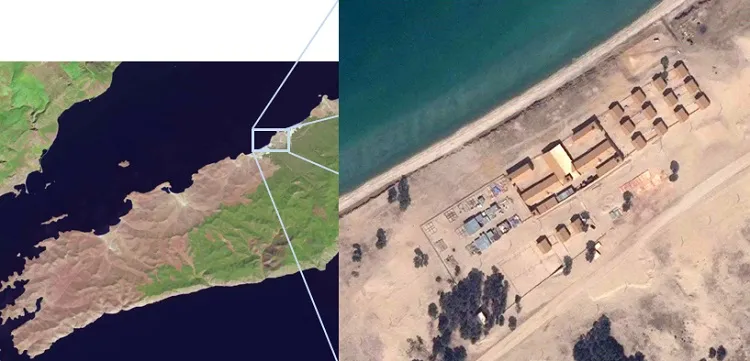
Olon Island. Combination of medium-resolution (Landsat-8, September 13, 2015) and very high-resolution (Pleiades, September 29, 2015) satellite images captures the general character and degree of construction on the northwestern coast of the island, as well as a detailed plan of unauthorized constructions in the Khuzhir settlement
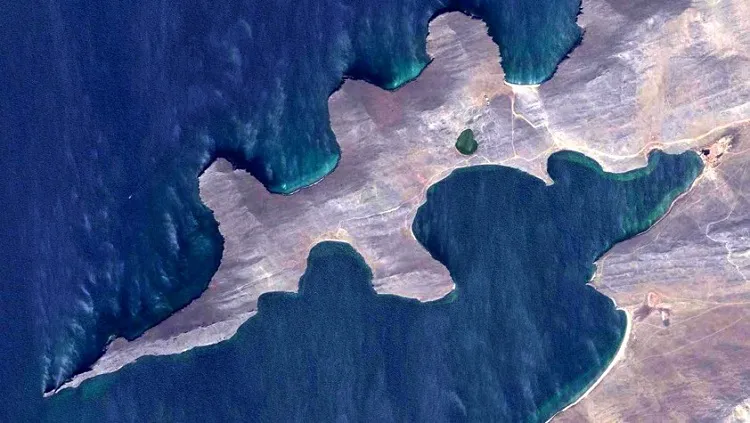
Using very high-resolution Pleiades satellite images, the spread of blue-green algae in bays and along anthropogenically modified shores of Lake Baikal is documented
Geoinformation Monitoring of Natural Resource Management
Methodological foundations have been developed for geoinformation monitoring of natural resource management processes in the Lake Baikal basin, as a strategic concept for managing information flows in a transboundary region under ecological constraints. The Geoinformation System of Natural Resource Management (GISNR) has been adopted as the basic technological unit for implementing this strategy. The information subsystem consists of various temporal digital coverages, maps, aerospace, statistical, literary information, and photographic materials. The information subsystem addresses the tasks of accumulation, structuring, storage, and updating of primary spatial-temporal information on electronic media. The spatial basis of the GIS is a universal grid (Transverse Mercator on the Krasovsky ellipsoid), created by combining topographic base with thematic digital layers: landscapes, soils, land use, administrative division.

Fig. 1 Structure of GISNR
The main functional task of this system is the unequivocal identification of each modeled object and its attribute, ensuring effective retrieval of necessary data in the information array. There is a foundation; what is needed is its updating, replenishment, and systematic monitoring.
Lake Baikal Basin Ecosystem: Digital Map and Geoinformation Database
The digital map "Lake Baikal Basin Ecosystems" at a scale of 1:500,000 has been compiled using the method of deciphering current materials from satellite imagery, integrating previously created multi-scale thematic mapping materials of individual territories within the basin, and author's field descriptions of ecosystems and vegetation. The map reflects the composition, structure, and current state of terrestrial ecosystems, highlighting new anthropogenic ecosystem areas significantly expanded compared to previous cartographic data. The map legend includes 71 ecosystem units corresponding to landscape units. To display the spatial variability of natural components of ecosystems, corresponding digital layer-maps (integrated GIS) were developed: morphogenetic relief types, soil cover, and vegetation of the basin, based on interpolation of various published thematic data and supplemented with information from archives and materials of over 50 years of field soil and vegetation studies by the Joint Russian-Mongolian Comprehensive Biological Expedition of the Russian Academy of Sciences and the Mongolian Academy of Sciences (JRCBE). The created spatial database of 5.1 GB represents a cartographic web service.
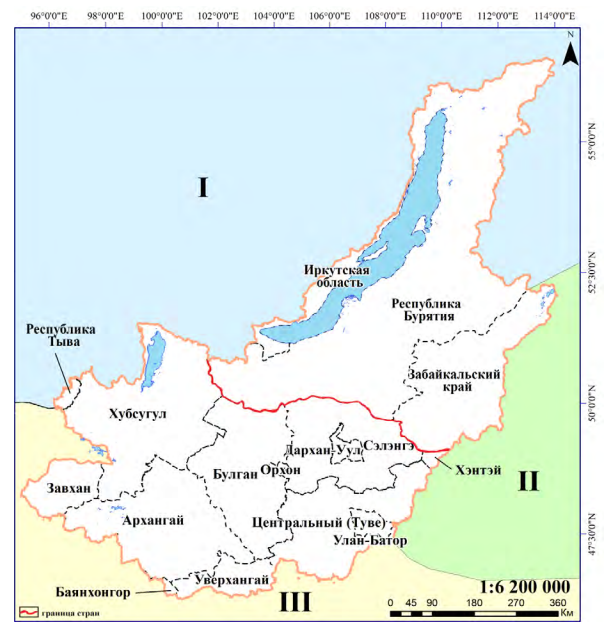
Fig. 2 Location of Lake Baikal Basin
The developed database is a cartographic web service that integrates all the aforementioned maps. Any user has access to the entire database (all data integrated into the "Lake Baikal Basin Ecosystems" web map), where they can view and annotate data, as well as access individual cartographic units (folder "Map of Lake Baikal Basin Ecosystems").
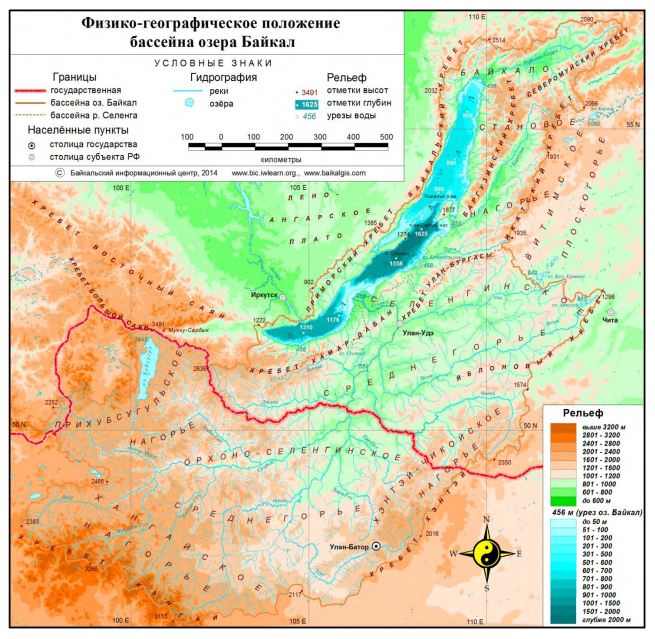
Fig. 3 Physico-geographical position of Lake Baikal Basin
The built database allows viewing, analyzing, and supplementing data on the landscape-ecological space of the Lake Baikal Basin at different levels of organization.
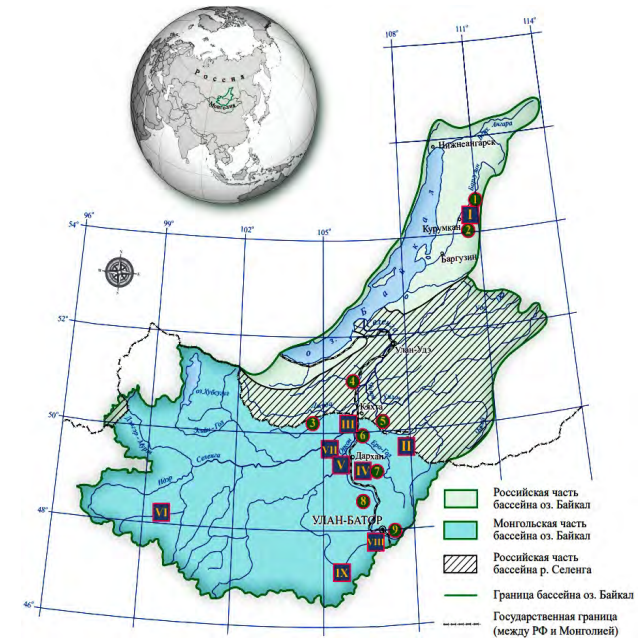
Fig. 4 Location of model polygons and key areas in the Lake Baikal Basin.
Results of Remote Sensing in the Ecology of Lake Baikal and Its Coastal Zone, River Basins, and Forest Area Over the Past Decade
Recreation on Lake Baikal
Recreation, as a significant human activity, is depicted on the map as a holistic phenomenon. The degree of territorial development of recreational activities is reflected through zoning (natural and socio-natural recreational zones). Zone boundaries correspond to the 1500 m contour line, determined by natural-landscape differentiation. Five levels of maximum allowable density (people/ha/day) have been identified.
District and settlement zoning of recreational areas (main and additional recreation centers) are key aspects, considering the typology of destinations and their specialization in forms and types of recreational activities.
Evaluation of coastal landscapes for recreational activities.
Naturally untouched landscapes directly and comprehensively satisfy the needs for physiologically necessary recreation (unconscious-reflexive), such as contemplation, solace, relaxation, etc. These landscapes (groups of landscapes) must be protected. The most accessible part of the Baikal coast demonstrates a certain degree of transformation of the surrounding environment. Socially specific (purposeful and conscious) forms of recreation predominate in these areas. The accumulation of problems associated with anthropogenic impact leads to landscape degradation and even loss of landscape diversity and complete uselessness of the territory in terms of recreation needs satisfaction.
The map shows the types and subtypes of natural landscapes within the Central Ecological Zone of Lake Baikal. It also illustrates areas of natural resource use, where comprehensive goals of landscape and territorial planning (preservation, improvement, development), as well as areas for protection and reclamation, must be achieved.
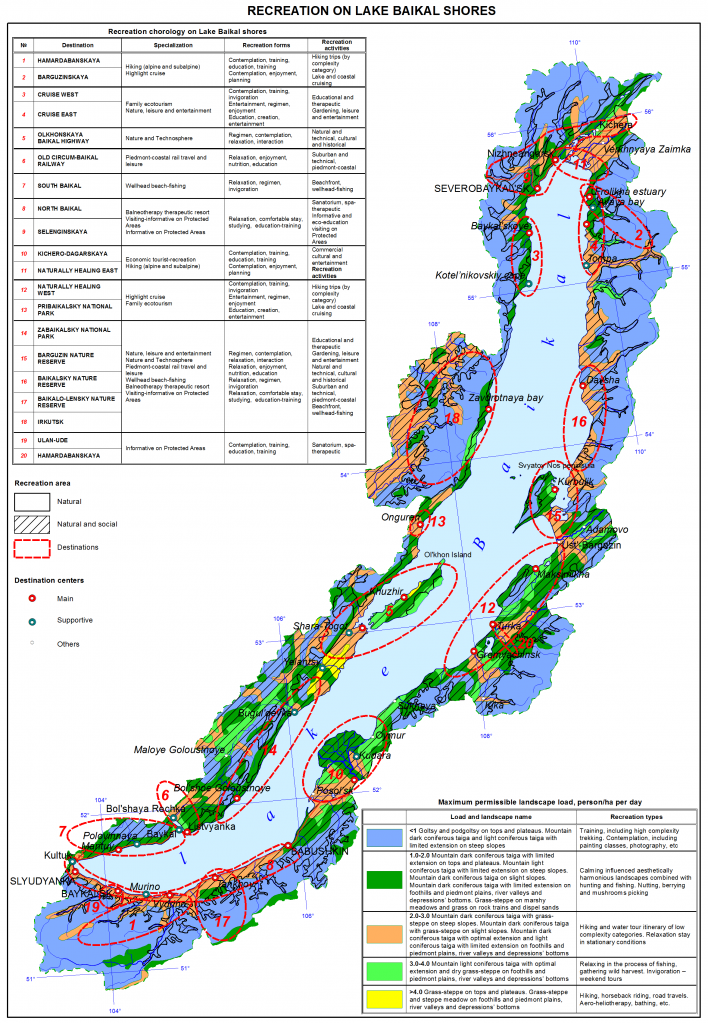
Fig. 5 Map of recreation zones along the shores of Lake Baikal
Digital Monitoring of the Baikal Natural Territory
The project's goal is to create a pilot network of digital monitoring stations for hydrological and hydrochemical conditions of Lake Baikal and its tributaries. In 2020, automated water level monitoring was organized in the lower and upper reaches of the Slyudyanka River using hydrostatic level sensors. In 2021, automated hydrometeorological stations were installed on the Irkut, Selenga, and Barguzin rivers.

Fig. 6 Installation of radar level sensor and solar panel on a railway bridge
Thus, an online monitoring system of hydrophysical, hydrological, and meteorological parameters of the Baikal ecological zone has been implemented, consisting of two stations located in two areas with different degrees of anthropogenic load.
In 2021, monitoring studies were conducted on the single outflow of Lake Baikal – the source of the Angara River, which reflects the total chemical composition of Lake Baikal water.

Fig. 7 Map-scheme of sampling at the source of the Angara River and the Irkutsk Reservoir
To study the state of water bodies of the Selenga River and the transformation of substances in aquatic ecosystems, the chemical composition of surface waters and bottom sediments of streams and lakes in the delta of the Selenga River was determined.

Fig. 8 Content of heavy metals in bottom sediments of the Selenga River, streams, and lakes of the delta in 2021
Thus, the beginning of installing ground remote sensors in complex ecological water areas of Lake Baikal lays the foundation for the regular observation system.
Experience in Using UAVs
In recent years, unmanned aerial vehicles (UAVs) have begun to be used and have proven themselves well in visualizing rapidly changing natural and anthropogenic environments. They are capable of monitoring changes in the shoreline with decreasing Lake Baikal levels, monitoring gully formation, fire and post-fire situations in forests and peatlands, conducting surveys of small salt lakes, dunes, sand dunes, snow-covered fields, residential buildings, agricultural fields, irrigation systems, roads, archaeological sites, quarries, etc.
Special programs (e.g., Agisoft) create 3D models and orthophotoplans. These models are then exported to mapping programs (ArcGIS, etc.) where they are used as full-fledged cartographic products to create detailed topoplanes.

Fig. 9 Eight ancient terraces of Lake Zun-Torey and landscape profile near the Teli camp
UAVs offer advantages in cost-effectiveness and obtaining high-resolution images quickly; orthophotoplans obtained with UAVs are a good analog to satellite images for small areas (up to several square kilometers). Future perspectives include using UAVs with other instruments: echo sounders, 3D terrestrial laser scanning station Leica ScanStationC10, electronic tachymeters, etc.
Monitoring Changes in Natural Complexes of the Southwest Coast of Lake Baikal Using Ground Observations and UAV Aerial Photography (Case Study: Listvyanka Village and Its Surroundings)
The natural complex of Listvyanka village and its surroundings has been significantly altered by human economic activities.
The aim of the study is to assess changes in the natural complexes of the village and its surroundings using ground methods and research with unmanned aerial vehicles.
Objects and methods of research. The objects of detailed study include soil and snow cover, surface and underground waters in the village and in the waters of Lake Baikal, within the influence zone of the settlement. Soil, snow, and water samples were collected, and chemical-analytical work was conducted using standardized and widely accepted methods.
Thus, the use of traditional (ground-based) physico-chemical methods in combination with unmanned aerial vehicles in monitoring studies of natural complexes allows for an expanded understanding of ongoing processes and phenomena. UAV operations are feasible in natural-landscape conditions of any complexity.
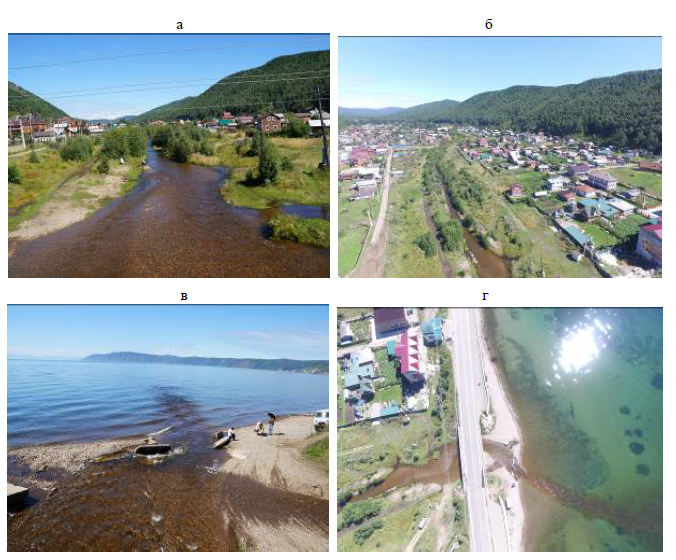
Fig. 10 Crossroads estuary: photography towards the village (a) and from the Phantom 3 Advanced quadcopter (height 54 m); inflow into Baikal: photography (c) and quadcopter shot (g) (height 240 m).
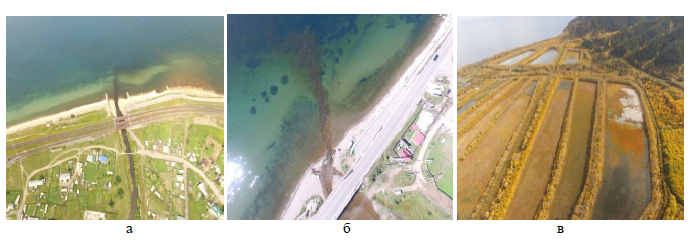
Fig. 11 Pollution discharge of the Mysovka River (a), suspended matter discharge of the Krestovka River (b), settling tanks of the BTC (c).
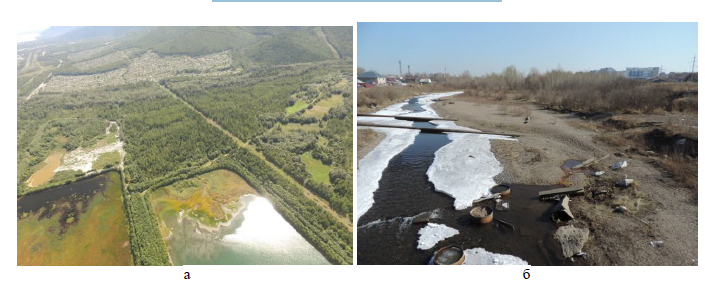
Fig. 12 Formation of landfill sites at BTC settling tanks (a), pollution of the floodplain and channel of the Ushakovka River (b).
Study of the Ice-Thermal Regime Parameters of Lake Baikal Using Remote Sensing Methods
The most important parameters defining the state of Lake Baikal's ecosystem are water surface temperature and characteristics of the ice cover. Given the large area of Lake Baikal's water surface (31.7 thousand km²), it is logical to use remote sensing satellite data to determine the characteristics of the lake's ice-thermal regime.
The aim of this study was to investigate the spatial-temporal distribution characteristics of the ice-thermal regime parameters of Lake Baikal using Advanced Very High Resolution Radiometer (AVHRR) data from 1998 to 2016.
A description is provided of the developed methodology for mapping the stages of snow-ice cover melting and breakup on Lake Baikal in the spring period, as well as an approach to mapping the lake water surface temperature during the ice-free period using AVHRR data. Examples of compiled maps of ice conditions and temperature distribution on the surface are presented. Based on the collected materials, the specifics of ice clearance in the Southern, Central, and Northern basins of Lake Baikal were studied, revealing that interannual fluctuations in the timing of ice clearance in these basins are in antiphase with interannual fluctuations in the Arctic Oscillation index. In addition, using water temperature fields, intra-annual and interannual variability in the distribution of Lake Baikal's surface temperature was examined, identifying August as the month with the greatest interannual temperature variability and the highest surface warming of this water body. An assessment was made of the contribution of several significant factors to the formation of temperature fields on Lake Baikal's surface.
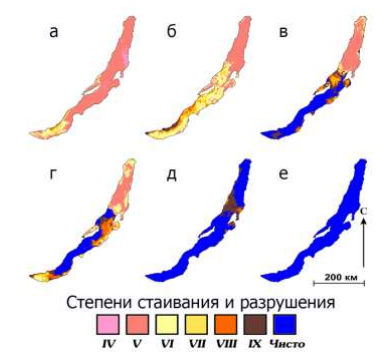
Fig. 13 State of the snow-ice cover on Lake Baikal by the degree of melting and breakup: (a) – May 10, 2010, (b) – May 17, 2010, (c) – May 25, 2010, (d) – May 4, 2011, (e) – May 14, 2012, (f) – May 21, 2012.
Within the framework of the conducted study using AVHRR data, electronic maps of Lake Baikal's water surface temperature during the ice-free period and maps of the state of the lake's snow-ice cover in the spring period were compiled. Regional features of ice clearance in the Southern, Central, and Northern basins of Lake Baikal were studied based on the collected materials. Connections between the timing of complete ice clearance from the lake basins and the values of atmospheric circulation indices were investigated, revealing that interannual fluctuations in the timing of ice clearance in these basins are in antiphase with interannual fluctuations in the Arctic Oscillation index. Furthermore, the results of this study conducted using AVHRR radiometer data allowed for a more detailed study of the characteristics of water temperature distribution on Lake Baikal's surface and an assessment of the contribution of several significant factors to the formation of temperature fields, thereby deepening our understanding of the temperature regime of this water body.
Geoinformation Support for Monitoring the Surface Layer of Lake Baikal Waters
The developed information system includes the following software tools: GIS packages Quantum GIS, MapWindowGIS, GRASS GIS; PostgreSQL databases with the PostGIS extension, Geoserver-based map servers. Spatial data from open sources were used to create cartographic materials: a navigational chart of Lake Baikal 1991 (Scale 1:200,000), the Irkutsk Reservoir pilotage, the Atlas of Lake Baikal 2001, Landsat-7 Earth remote sensing data, AsterGDEM and SRTMv4 relief data, WMS layers from the Military Topographic Service (Scale 1:100,000), spatial materials from OpenStreetMaps.org, and Microsoft.com/maps.
This work addresses the task of improving the lake water environment monitoring system used by the Federal Water Resources Agency units. Like other types of monitoring, this system is characterized by several drawbacks. For example, the currently applicable water quality standards and permissible environmental impact norms are completely inappropriate for Lake Baikal, as the established MPC values are incompatible with concentrations of dissolved substances typical of the natural environment (hereinafter referred to as background levels). This fact has led to diametrically opposed opinions on both the current water quality and some hydrochemical properties of the lake. Other issues identified by sources involved in the monitoring program include untimely receipt of monitoring results, an uninformative set of determinable parameters, questionable data quality, and unjustified criteria for detecting abnormal natural environment conditions, preventing adequate conclusions about the lake's water environment.

Fig. 14 Geological-geophysical work on Lake Baikal
A multi-component distributed geoinformation system has been created to support the entire data management cycle for conducting state monitoring of the lake water environment. The system is based on the experience gained in conducting ecological monitoring under specific regional external conditions, complies with current environmental legislation requirements, and is organized in accordance with the modern level of information technologies. New data on the chemical composition of the surface layer of water throughout Lake Baikal's water area have been obtained. The distribution features of the concentrations of substances regulated by the monitoring program, characteristic of various basins of Lake Baikal, have been studied. These data allow adjustments to be made to the existing monitoring scheme.
Enhanced Classification of Aquatic Wetland Habitats Using Eight-band High-resolution Satellite Imagery and a Hybrid Approach
Remote sensing technology has long been used for inventorying and monitoring aquatic wetland habitats. The accuracy and level of detail of wetland habitat maps obtained using medium-resolution images and traditional methods were limited and often unsatisfactory. An assessment was made of the utility of the recently launched eight-band high-resolution satellite system (WorldView-2; WV2) for identifying and classifying freshwater deltaic aquatic wetland vegetation and aquatic habitats in the Selenga River delta on Lake Baikal, using a hybrid approach and new Indicator Species Analysis (ISA). An overall classification accuracy of 86.5% (Kappa coefficient: 0.85) was achieved for 22 classes of aquatic and aquatic wetland habitat types, indicating that additional indicators such as Normalized Difference Vegetation Index and image texture were valuable for increasing overall classification accuracy, particularly for distinguishing specific habitat classes. The analysis showed that including four WV2 spectral bands from less frequently used parts of the spectrum, alongside more traditional passbands, contributed to an approximately 4% overall increase in classification accuracy, with significant improvements in the ability to distinguish specific communities.
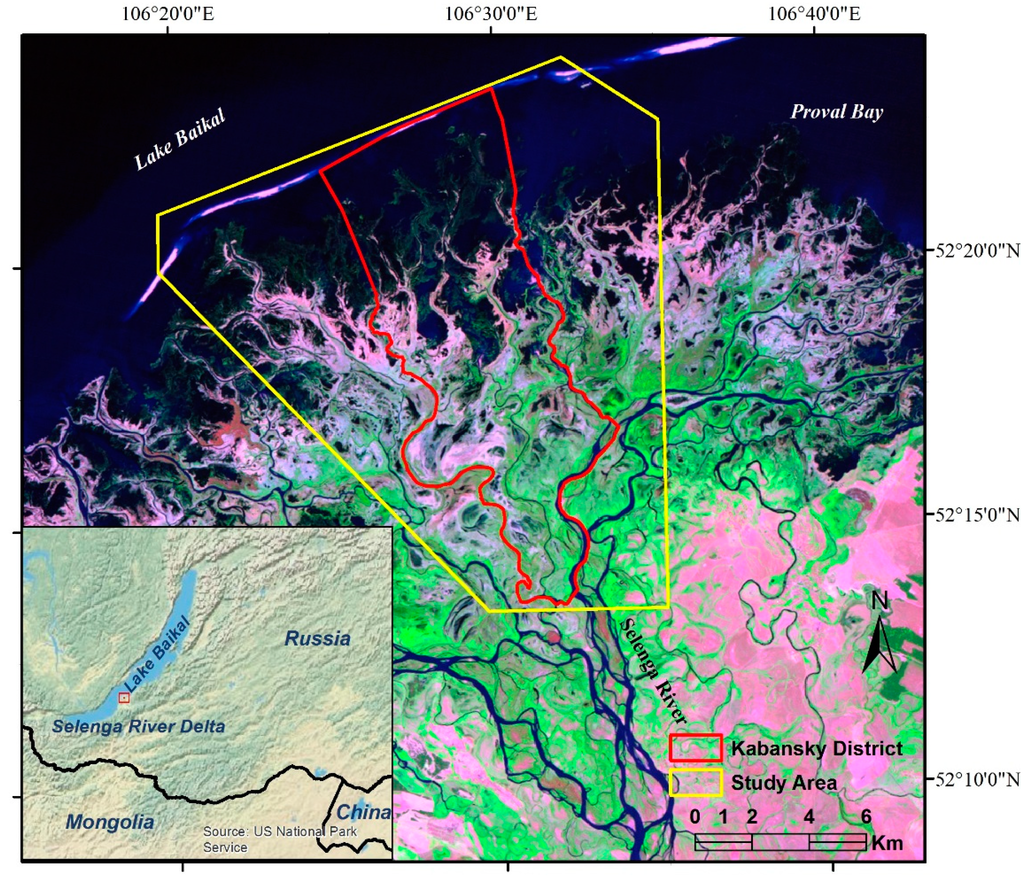
Fig. 15 Location of the study polygon in the Selenga River delta in the Kabansky district of the Baikal Nature Reserve against channels 7, 4, and 3 from the WorldView-2 (WV2) image.

Fig. 16 Adjacent multispectral images from WorldView-2 (composite image of channels 7, 5, and 3 in near-infrared range in artificial colors) with ground control points and ground points.
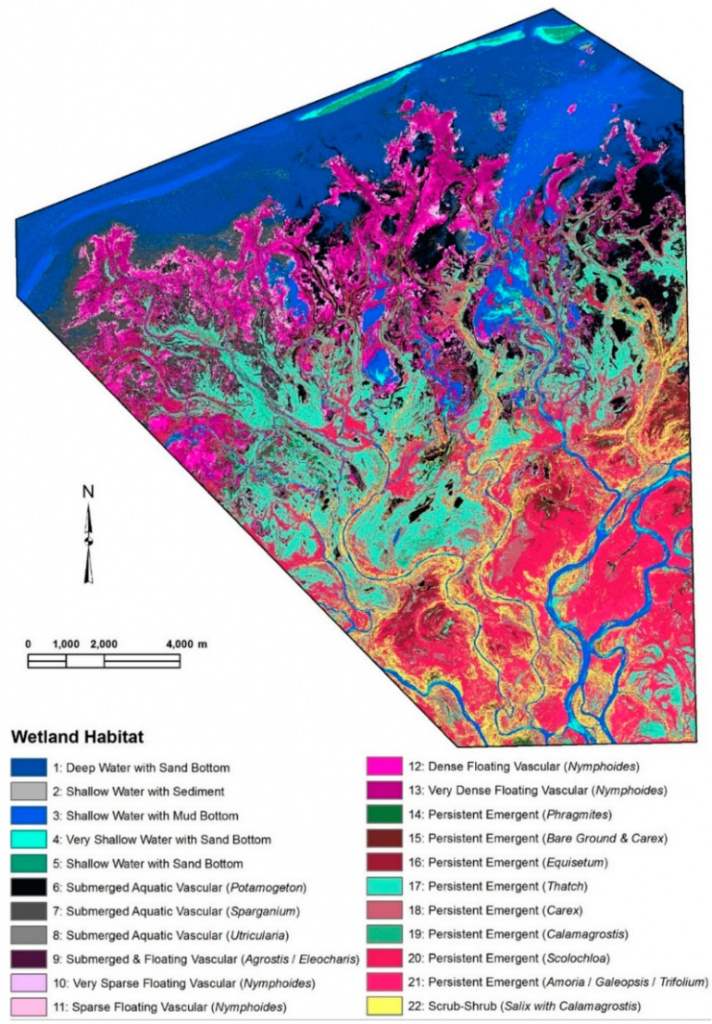
Fig. 17 Classification of aquatic and aquatic wetland habitats by genus and community at level 5.
Due to water level fluctuations, large and heterogeneous aquatic wetland systems are likely among the most complex systems to inventory. Remote sensing data and increasingly effective analysis provide informative baseline data for scientists and resource managers to study the consequences of climate change, altered hydrology, and other disturbances, as well as adaptive management methods for aquatic wetland systems.
Conclusion
To successfully address the challenges facing Lake Baikal, it is necessary to:
-
Recognize the ecological problems of Lake Baikal as national priority tasks and ensure appropriate funding. The best approach could be implemented through national projects utilizing comprehensive remote sensing methodologies, creating a fully functional ecological system.
-
Eliminate legal "loopholes" by systematically adjusting federal and regional documents, including regulatory indicators considering the current natural characteristics of the lake.
-
Select ecologically efficient and economically viable technologies suitable for Lake Baikal, such as wastewater treatment and solid waste disposal.
-
Organize economic and recreational activities in the areas surrounding Lake Baikal in an environmentally responsible manner.
-
Conduct territorial planning for the Lake Baikal surrounding territories based on landscape planning principles, including adjusting the boundaries of the protected water zone in settlements using remote sensing methods.
-
Continue scientific research on the Lake Baikal ecosystem and adjacent areas using the latest international remote sensing methodologies and tools.
Comprehensive ecological atlases of the Baikal region can serve as a database for solving environmental problems in the Baikal region.
